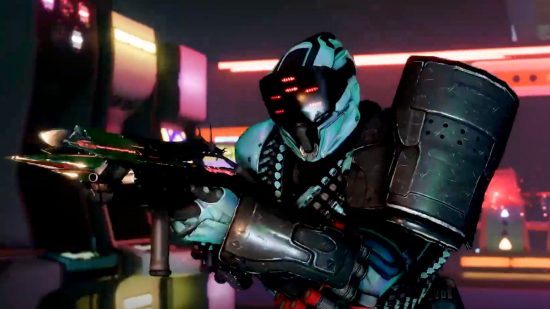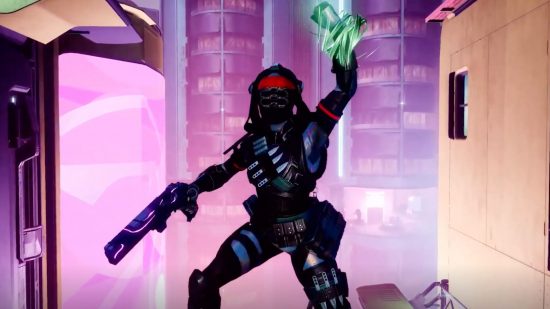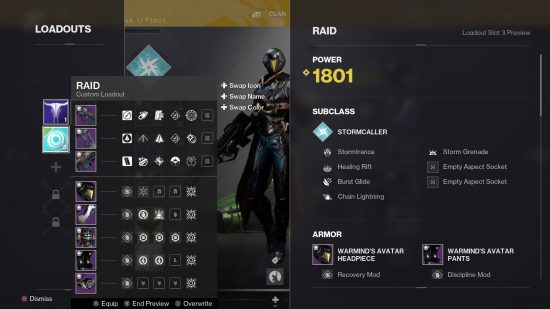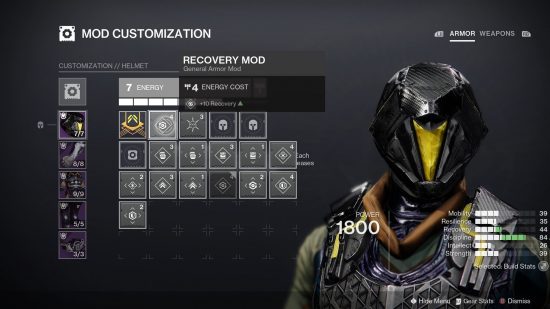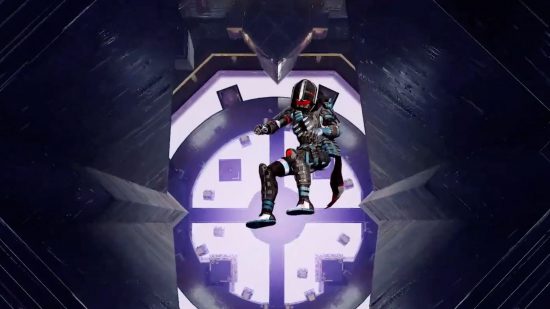What are Destiny 2 loadouts? Coming with Lightfall, loadouts let players rapidly transition between character builds. It can be tedious to change between subclasses only to have to equip specific mods, weapons, and perks that complement that particular subclass or character objective. And, with the addition of Aspects and Fragments over the past few years, the game’s buildcrafting systems have only become more complex.
That’s why Bungie is introducing loadouts to Destiny 2, which allow you to rapidly switch between your best Destiny 2 Hunter builds, Warlock builds, and Titan builds. Here’s everything you need to know about Destiny 2 loadouts, coming to the popular FPS game with the Destiny 2 Lightfall release date and introduction of the Strand subclass.
What are Destiny 2 loadouts?
Currently, players who want to create and save Destiny 2 builds must do so through third-party apps such as Destiny Item Manager (DIM). This is a huge pain point because Guardians often spend time outside the game crafting builds for specific activities. The primary objective with loadouts is to provide a quick and convenient way to suit up for any in-game activity.
Bungie states that its goals with loadouts are to allow players to quickly swap between gear without the need to visit the vault or other screens, decrease player time spent between play sessions due to Guardians needing to rebuild their loadouts, and create ways to label loadouts for easy identification. Players can flag specific loadouts as good for raids, Crucible, Gambit, and so on.
While Bungie introduced loadouts as part of its Lightfall preview materials, the game developer recently shared more details about the changes to its current buildcrafting system as part of its This Week at Bungie (TWAB) series.
A loadout preview screen provides a snapshot view of each loadout. Presently, players must hover over each gear piece to see their equipped mods. The loadouts preview shows specific weapons and perks. Therefore, players can easily see which weapons and rolls they’ve saved for specific builds. A new tab will also make it easy for players to see their current weapons and stats without having to load back into the character screen each time they want to review their weapon stats.
Bungie has confirmed that things like ships and sparrows will not be something players can save in their loadouts initially but that the team may choose to include these cosmetic items in loadouts in the future.
You will be able to save ten loadouts per character, for a total of 30 loadouts. Players can unlock loadout slots by progressing through the Guardian Ranks system, which is also new to Lightfall. Completing specific objectives will earn you ranks demonstrating mastery of various Destiny 2 activities.
Destiny 2 mod customisation changes
With Lightfall, a mod customisation screen will make it much easier to manage your armour mods. Pre-Lightfall mods are assigned to specific armour types and are difficult to track. Switching subclasses often involves changing mods, and forgetting to adapt even one mod to the current task can destroy the entire build. But, it can be tedious to remember to change as many as 20 mods to complement any subclass Aspects and Fragments, not to mention updating specific weapons designed for particular activities such as taking down specific types of champions.
Regarding the revamped mod system, the developers wanted to cut down on player time spent managing mods, remove limitations that cause confusing experience, give players better insight into how to earn mods, remove the need to wait for Ada-1 to sell specific mods, and retune mods to adapt to play styles while also combating ‘power creep.’
The new screens will quickly show players equipped mods and how they are impacting the players’ stats. One significant change is that mods will no longer correspond with specific energy types, meaning you don’t have to wear Solar, Arc, Void, or Stasis-specific armour to take advantage of specific mods.
Further, Artifact perks will no longer require mod slots. This is another way Bungie expedites the buildcrafting process, as players often have to change their entire builds simply because they need a specific Artifact mod that corresponds with an armour piece and requires a set number of armour stat points to use.
Destiny 2 developers are also making it easier to counter specific champions. As of Lightfall, players can counter specific types of champions with specific impacts tied to the various subclasses.
- Barrier champions (Solar, Void, Strand)
- Void volatile rounds from weapons will now pierce barriers and stun barrier champions.
- Solar radiant effects will piece champion shields and stun barrier champions.
- Strand will also have a method of piercing barriers.
- Overload champions (Arc, Stasis, Void)
- Damaging an overload champion by triggering the Arc jolted condition now stuns them.
- Void suppression will now stun overload champions.
- Stasis slow will also stun overload champions.
- Unstoppable champions (Arc, Solar, Stasis, Strand)
- Arc blinding an unstoppable champion stuns them.
- Encasing unstoppable champions in Stasis and then shattering them stuns them.
- Triggering a Solar ignition now stuns unstoppable champions.
Strand will also have an unstoppable champion counter.
Bungie is also removing Warmind cells and elemental well mechanics, replacing them with damage-type-specific spawns.
- Ionic traces for Arc.
- Firesprite for Solar.
- Void breaches for Void.
- Stasis Shards for Stasis.
- Strand will also have an object.
Picking up these objects will grant ability energy or have other effects depending on your subclass build, using Aspects and Fragments to trigger specific impacts.
Buildcrafting changes will also introduce an armour charge system. This process will be overall streamlined and easier to use. Importantly, mods players have used in the past will now have different functions, so buildcrafters should plan to keep a close eye on how these changes will impact their builds.
That’s everything you need to know about Destiny 2 loadouts, coming with Lightfall and Destiny 2 season 20. As you look forward to the forthcoming DLC, you may want to take a final pass at Destiny 2 season 19 activities, such as the Spire of the Watcher dungeon and the Revision Zero exotic quest, to ensure you’re appropriately geared up to enjoy everything Lightfall has to offer.
